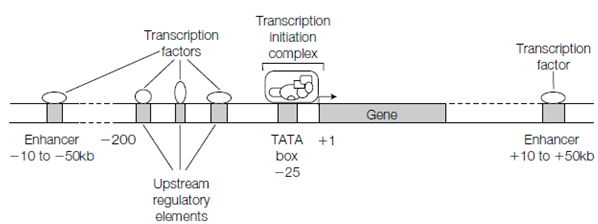Mechanism of regulation:
A number of protein-coding genes are active in all cells and are needed for so- called house-keeping functions like as the enzymes of glycolysis, the citric acid cycle and the proteins of the electron transport chain. Moreover, some genes are active only in specific cell kinds and are responsible for defining the specific characteristics and function of those cells; for instance immunoglobulin genes in lymphocytes, myosin in muscle cells. Additionally, the proteins expressed through any given cell may modify over time (for instance during early development) or in response to external stimuli, like as hormones. The Eukaryotic cells can regulate the expression of protein-coding genes at a number of levels but a prime site of regulation is transcription.
Transcriptional regulation in a eukaryotic cell that genes are transcribed and at what rate) is mediated through transcription factors (other than the common transcription factors) that recognize and bind to short regulatory DNA sequences (control parts) related with the gene. These sequences are also known as cis-acting elements (or simply cis-elements) since they are on the similar DNA molecule as the gene being controlled (cis is Latin for 'on this side'). The protein transcription factors which bind to these parts are also known as trans-acting factors (or simply trans-factors) in which the genes encoding them can be on variant DNA molecules instance for on different chromosomes. The transcription factors that regulate specific gene transcription do so through interacting with the proteins of the transcription initiation complex and should either increase (activate) or decrease (repress) the rate of transcription of the goal gene. Classically each protein-coding gene in a eukaryotic cell has various control elements in its promoter and therefore is under the control of various transcription factors that interact with each other and with the transcription initiation complex through protein: the protein interaction to determine the rate of transcription of that gene.

Figure: Control regions that regulate transcription of a typical eukaryotic protein-coding gene. Although shown as distinct entities here for clarity, in vivo the different regulatory proteins bound to the control elements and distant enhancers interact with each other and with the general transcription factors of the transcription initiation complex to modulate the rate of transcriptional initiation.